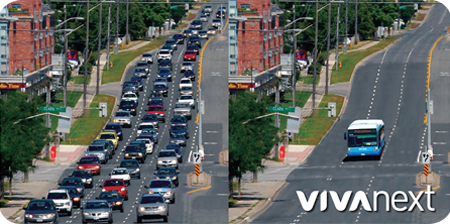How to reduce the gridlock in the Greater Toronto Area is a topic that is getting a lot of air-time from commentators of all descriptions. And for good reason – gridlock has been described by the Toronto Board of Trade as costing the GTA’s economy more than $6 Billion a year.
How those numbers are calculated, and what lies behind them, isn’t always so clear. One of the best breakdowns that I have read is the paper developed by the Toronto Board of Trade last year urging governments to invest more in transit. The paper, called Let’s Break the Gridlock provides this description of how gridlock costs us all time – and how that time costs money.
The biggest concern about gridlock in Toronto from an economic perspective is that the increasingly clogged roads slow down business, and therefore undermine profits. These so-called “congestion costs” affect different industries in different ways, each with their own price tag. For example, in an economy that is increasingly based on “just in time” strategies, businesses order extra stock or supplies or equipment as it is needed instead of warehousing it. But if the delivery is unreliable, businesses will need to order earlier, tying up money in extra goods and paying for warehousing. That costs extra money, and those increased prices will be passed on to the customer.
Another huge price tag associated with gridlock is how long it takes businesses to actually move their goods around. The congestion costs hurt businesses in many ways such as increased shipping and fuel costs, higher labour costs per shipment due to less productive drivers, and reduced travel speeds. Big shippers who need to deliver their products to small businesses throughout the GTA, for example soft-drink bottlers who need to make deliveries to many small convenience stores and restaurants across the region, face significantly higher costs due to congestion, and the snarled roads their drivers travel. They can make fewer deliveries per day, and each delivery costs more.
And for employers, employee recruitment is negatively impacted by the difficult commutes faced by so many in the GTA. As the Board of Trade paper notes, the lack of transit is a serious barrier for employers in hiring skilled young professionals. And nowhere is this problem more severe than in the 905 areas, where employers have realized that the lack of rapid transit actually adds to the cost of doing business in the suburbs. In fact, employers are increasingly seeing the benefits of having nearby transit, so that they can attract the best employees.
With this last reason in mind, we’re fortunate that York Region is planning for the future with vivaNext. We’re going to have great rapid transit when the construction is complete, so that people can move around our region and make convenient connections across the GTA. And with every full viva vehicle, we can get 70 cars off the road, which will reduce congestion for everyone.
Defeating gridlock is going to take time, and vision, and money. But given the huge price congestion is already costing, there’s really no alternative.

